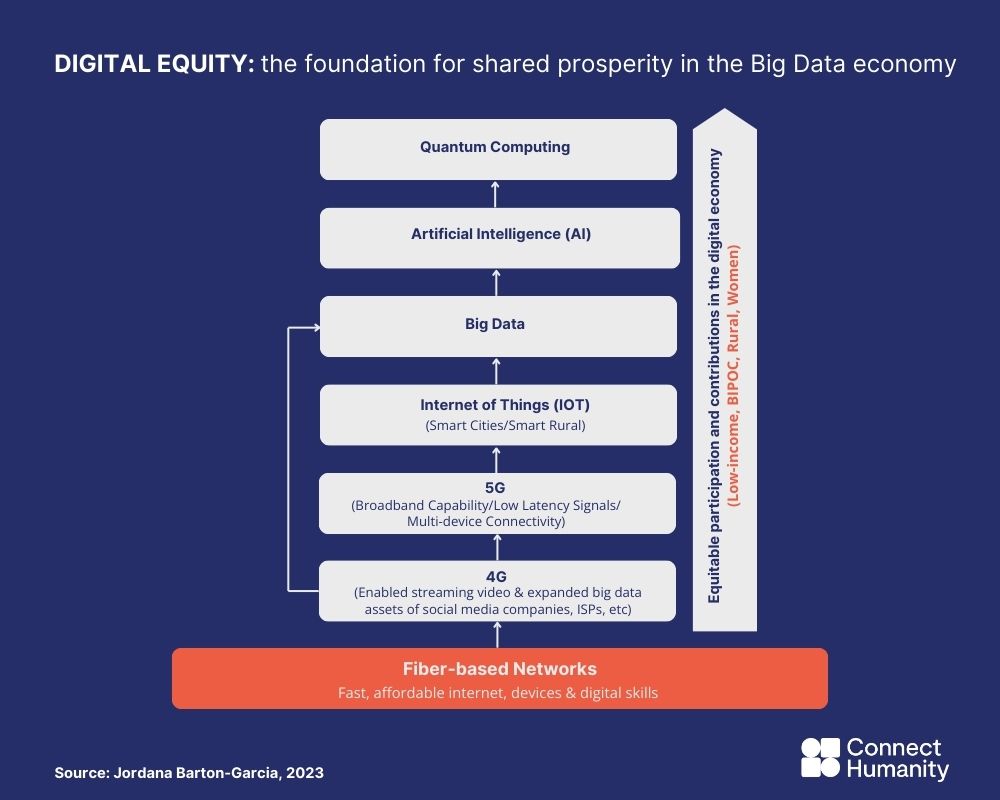Is data the new oil? Why South Texas should pay attention to this well-worn tech cliché
In the San Antonio Express News, Jordana Barton-Garcia argues that digitalization can power the economic future of South Texas

This op-ed was originally published by the San Antonio Express News
Data is the new oil” is a well-worn cliché in tech circles. But in Texas, as we look to secure our economic future in a world moving away from carbon, we should pay attention. The engine of growth for our state, and the future prosperity for our institutions, businesses and our children, resides not in drilling, but in data, digital technology and high-speed connectivity.
San Antonio and South Texas are making promising moves toward this future. The efforts of organizations such as Geekdom to create a startup scene in the city are to be applauded. But there is also a huge digital divide holding back the South Texas Triangle, a region that stretches from San Antonio to the Rio Grande Valley and Corpus Christi and extends into Northern Mexico. In this latest installment in the San Antonio Forward op-ed project, let’s examine how the digital divide can be addressed through broadband connectivity and appropriate workforce development and training.
Across South Texas, there are broadband deserts where families and businesses cannot gain access to reliable high-speed internet. In the Rio Grande Valley, known as the RGV, about 45% of households lack a fixed internet subscription. In these communities, online classes, remote work, telehealth, internet-based businesses and basic tools, such as digital point-of-sale systems, are off the table.
For too long, policymakers have allowed this to continue, with a complacency that author and Penn State University communications professor Christopher Ali calls “the politics of good enough.” This view says investing in fiber broadband is too expensive and low-income and rural people should put up with slow, legacy infrastructure.
This attitude isn’t just unfair to the families and businesses on the wrong side of the digital divide — which are disproportionately in low-income, rural and communities of color — it sets our entire region up to be left behind. A 2019 U.S. Chamber of Commerce study found that just closing the rural digital divide in Texas would add $3.8 billion to the state’s annual GDP.

Beyond ‘good enough’
The good news is we’ve never had a better opportunity to address our digital disparities. Texas has been allocated $3.3 billion to subsidize internet expansion in underserved areas through the Broadband Equity Access and Deployment, or BEAD, program; part of the federal government’s wider Infrastructure Investments and Jobs Act. Beyond infrastructure, there is funding for digital skills programs and subsidies to make service and devices affordable for low-income families.
If we grab this opportunity with both hands, think creatively and bring the right partners together, then we can move beyond the politics of “good enough,” to build the very foundation for entrepreneurship and innovation that’s good for all. We can set up the South Texas Triangle to be a thriving hub of job growth and economic dynamism within the next 10 years.
Federal funding alone will not get the job done. To succeed, we need to bring together the right partners locally who know and care about our communities.
That’s why we have created the Rio Grande Valley Broadband Coalition, supported by a spectrum of organizations. Among these organizations are the Lower RGV Development Council, Region One Educational Service Center, regional internet service providers and Connect Humanity, a nonprofit dedicated to helping underserved communities close the digital divide.
These organizations are working alongside San Antonio-based organizations such as the Intercultural Development and Research Association and Methodist Healthcare Ministries. The coalition is working to expand digital access, build skills, promote higher wage jobs and the digitalization of small business across Willacy, Cameron, Hidalgo and Starr counties, so we can unlock our communities’ abundant human and economic potential.
One of the coalition’s main focus areas is health care technology and the expansion of telehealth. The South Texas region has some of the worst health outcomes in the country and the highest cost of care.
High-tech health
The Dallas Fed’s 2018 special report, “At the Heart of Texas,” points to health care as one of the top-two industries for job creation in the RGV and South Texas. Nationally, health care has overtaken retail and manufacturing as the biggest job creator. By setting up our high-tech health sector for success, we can foster a new generation of startups, create new well-paying jobs and improve health care outcomes. But we can’t do this without first investing in fiber-based internet infrastructure.
We don’t need to look far to see communities leading the way. In Hidalgo County, the city of Pharr has created a municipal broadband network: TeamPharr.Net. They are 80% through building a city-owned fiber network that has already delivered fast, affordable, reliable broadband to 3,000 residents.
The city’s mayor, Dr. Ambrosio Hernandez, a pediatric surgeon, said: “Investing in fiber infrastructure is an investment in our people and the potential of our children. Their entrepreneurial spirit and scientific inquiry will lead to advancements in health care, climate resilience, human-centered artificial intelligence and more.”
The investment is already creating a tech ecosystem and delivering returns. For instance, two of the small businesses Pharr officials hired to complete the last-mile connection to residents, have added 72 permanent tech positions and are poised to expand networks to nearby communities. TeamPharr.Net itself has hired 20 additional staff, plans to expand its apprenticeship programs and is partnering with other regional internet service providers.

The city is not short of ideas for putting this new infrastructure to good use. Pharr has created a new public health department to improve services for city residents and to surrounding colonia communities and small towns. Officials will provide access to preventative care and health monitoring with the expanded use of telehealth. And Pharr is positioning itself to become an innovation center for addressing the social determinants of health, telehealth, disease monitoring, biotechnology and AI and quantum computing for precision health care.
This is what the future for the South Texas Triangle looks like. Hernandez and the communities in the region know the opportunity cost is too high not to invest in infrastructure fit for the 21st century and beyond.
Jordana Barton-Garcia is an expert in South Texas regional economic development as well as the digital economy. She is senior fellow with Connect Humanity, co-chair of the RGV Broadband Coalition and a member of the Statewide Working Group, Texas Broadband Development Office.
Keep in touch
To learn more about our work follow us on social media, subscribe to our newsletter, and write to us anytime at info@connecthumanity.fund.
